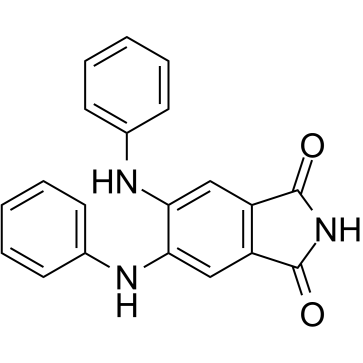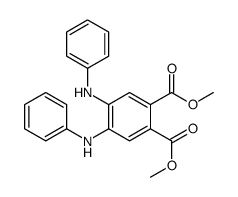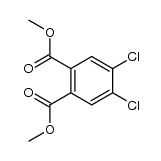145915-58-8
| 中文名 | 4,5-二苯胺基酞酰亚胺 |
|---|---|
| 英文名 | 5,6-dianilinoisoindole-1,3-dione |
| 英文别名 |
5,6-bis-phenylamino-isoindole-1,3-dione
DAPH-1 4,5-dianilinophthalimide DAPH 5,6-bis-phenylamino-isoindole-1,3-dione,DAPH |
| 描述 | CGP52411 (DAPH) 是一种高选择性,有效,口服活性和 ATP 竞争性的 EGFR 抑制剂,IC50 为 0.3 μM。CGP52411 阻止有毒的 Ca2+ 离子流入神经元细胞,并显着抑制和逆转与阿尔茨海默症相关的 β-amyloid (Aβ42) 原纤维聚集物的形成。 |
|---|---|
| 相关类别 | |
| 靶点 |
EGFR:0.3 μM (IC50) Amyloid-β |
| 体外研究 | CGP52411(DAPH;0-100μM;90分钟;A431细胞)处理抑制体外自磷酸化和c-src自磷酸化,并呈剂量依赖性,IC50s分别为1μM和16μM。CGP52411处理还显示p185c-erbB2酪氨酸磷酸化的浓度依赖性降低,IC50值为10μM[1]。cgp5241(DAPH)抑制IC50值为16μM的c-src激酶。cgp5241抑制IC50值为80μM的猪脑PKC同工酶。cgp5241抑制常规PKC同工酶(cPKCsα、β-1、β-2和γ),但不抑制非常规PKC同工酶(nPKCsδ、ε和ζ)或非典型PKC同工酶(aPKCη)[1]。Western Blot分析[1]细胞系:A431细胞浓度:0μM,0.1μM,1μM,10μM,50μM,100μM孵育时间:90分钟结果:IC50为1μM时以剂量依赖性方式抑制体外自磷酸化。IC50为16μM时抑制c-src自磷酸化,并导致p185c-erbB2酪氨酸磷酸化的浓度依赖性降低,估计IC50值为10μM。 |
| 体内研究 | CGP52411(3.2 mg/kg、6.3 mg/kg、12.5 mg/kg、25 mg/kg和50 mg/kg;口服;每日;15天;雌性BALB/c裸鼠)体内治疗A431和SK-OV-3肿瘤的异种移植物,并具有抗肿瘤活性[1]。动物模型:雌性BALB/c裸鼠注射a431细胞[1]剂量:3.2mg/kg、6.3mg/kg、12.5mg/kg、25mg/kg、50mg/kg;口服;每日;15天结果:50mg/kg~6.3mg/kg剂量组有抗肿瘤作用。 |
| 参考文献 |
| 密度 | 1.374 g/cm3 |
|---|---|
| 熔点 | 199-202℃ |
| 分子式 | C20H15N3O2 |
| 分子量 | 329.35200 |
| 精确质量 | 329.11600 |
| PSA | 70.23000 |
| LogP | 4.53220 |
| 储存条件 | 2-8°C |
|
Section1. IDENTIFICATION OF THE SUBSTANCE/MIXTURE Product identifiers Product name: DAPH CAS-No.: 145915-58-8 Section2. HAZARDS IDENTIFICATION
Classification of the substance or mixture
Not a hazardous substance or mixture according to Regulation (EC) No 1272/2008 This substance is not classified as dangerous according to Directive 67/548/EEC. Label elements The product does not need to be labelled in accordance with EC directives or respective national laws. Other hazards - none Section3. COMPOSITION/INFORMATION ON INGREDIENTS Substances Synonyms: 4,5-Dianilinophthalimide 5,6-Bis(phenylamino)-1H-isoindole-1,3(2H)-dione Formula: C20H15N3O2 Molecular Weight: 329,35 g/mol Section4. FIRST AID MEASURES Description of first aid measures General advice Consult a physician. Show this safety data sheet to the doctor in attendance. If inhaled If breathed in, move person into fresh air. If not breathing, give artificial respiration. Consult a physician. In case of skin contact Wash off with soap and plenty of water. Consult a physician. In case of eye contact Flush eyes with water as a precaution. If swallowed Never give anything by mouth to an unconscious person. Rinse mouth with water. Consult a physician. Most important symptoms and effects, both acute and delayed To the best of our knowledge, the chemical, physical, and toxicological properties have not been thoroughly investigated. Indication of any immediate medical attention and special treatment needed no data available Section5. FIREFIGHTING MEASURES Extinguishing media Suitable extinguishing media Use water spray, alcohol-resistant foam, dry chemical or carbon dioxide. Special hazards arising from the substance or mixture Carbon oxides, nitrogen oxides (NOx) Advice for firefighters Wear self contained breathing apparatus for fire fighting if necessary. Further information no data available Section6. ACCIDENTAL RELEASE MEASURES Personal precautions, protective equipment and emergency procedures Use personal protective equipment. Avoid dust formation. Avoid breathing vapors, mist or gas. Avoid breathing dust. Environmental precautions Do not let product enter drains. Methods and materials for containment and cleaning up Pick up and arrange disposal without creating dust. Sweep up and shovel. Keep in suitable, closed containers for disposal. Reference to other sections For disposal see section 13. Section7. HANDLING AND STORAGE Precautions for safe handling Avoid formation of dust and aerosols. Provide appropriate exhaust ventilation at places where dust is formed.Normal measures for preventive fire protection. Conditions for safe storage, including any incompatibilities Store in cool place. Keep container tightly closed in a dry and well-ventilated place. Recommended storage temperature: 2 - 8 °C Specific end uses no data available Section8. EXPOSURE CONTROLS/PERSONAL PROTECTION Control parameters Components with workplace control parameters Exposure controls Appropriate engineering controls Handle in accordance with good industrial hygiene and safety practice. Wash hands before breaks and at the end of workday. Personal protective equipment Eye/face protection Use equipment for eye protection tested and approved under appropriate government standards such as NIOSH (US) or EN 166(EU). Skin protection Handle with gloves. Gloves must be inspected prior to use. Use proper glove removal technique (without touching glove's outer surface) to avoid skin contact with this product. Dispose of contaminated gloves after use in accordance with applicable laws and good laboratory practices. Wash and dry hands. The selected protective gloves have to satisfy the specifications of EU Directive 89/686/EEC and the standard EN 374 derived from it. Body Protection Choose body protection in relation to its type, to the concentration and amount of dangerous substances, and to the specific work-place., The type of protective equipment must be selected according to the concentration and amount of the dangerous substance at the specific workplace. Respiratory protection Respiratory protection is not required. Where protection from nuisance levels of dusts are desired, use type N95 (US) or type P1 (EN 143) dust masks. Use respirators and components tested and approved under appropriate government standards such as NIOSH (US) or CEN (EU). Section9. PHYSICAL AND CHEMICAL PROPERTIES Information on basic physical and chemical properties a) AppearanceForm: solid Colour: orange b) Odourno data available c) Odour Thresholdno data available d) pHno data available e) Melting point/freezingMelting point/range: 207 - 208 °C point f) Initial boiling point and no data available boiling range g) Flash pointno data available h) Evaporation rateno data available i) Flammability (solid, gas) no data available j) Upper/lowerno data available flammability or explosive limits k) Vapour pressureno data available l) Vapour densityno data available m) Relative densityno data available n) Water solubilityno data available o) Partition coefficient: n- no data available octanol/water p) Autoignitionno data available temperature q) Decompositionno data available temperature r) Viscosityno data available s) Explosive propertiesno data available t) Oxidizing propertiesno data available Other safety information no data available Section10. STABILITY AND REACTIVITY Reactivity no data available Chemical stability no data available Possibility of hazardous reactions no data available Conditions to avoid no data available Incompatible materials Strong oxidizing agents Hazardous decomposition products Other decomposition products - no data available Section11. TOXICOLOGICAL INFORMATION Information on toxicological effects Acute toxicity no data available Skin corrosion/irritation no data available Serious eye damage/eye irritation no data available Respiratory or skin sensitization Prolonged or repeated exposure may cause allergic reactions in certain sensitive individuals. The preceding data, or interpretation of data, was determined using Quantitative Structure Activity Relationship (QSAR) modeling. Germ cell mutagenicity no data available Carcinogenicity IARC:No component of this product present at levels greater than or equal to 0.1% is identified as probable, possible or confirmed human carcinogen by IARC. Reproductive toxicity no data available Specific target organ toxicity - single exposure no data available Specific target organ toxicity - repeated exposure no data available Aspiration hazard no data available Potential health effects InhalationMay be harmful if inhaled. May cause respiratory tract irritation. IngestionMay be harmful if swallowed. SkinMay be harmful if absorbed through skin. May cause skin irritation. Eyes May cause eye irritation. Signs and Symptoms of Exposure To the best of our knowledge, the chemical, physical, and toxicological properties have not been thoroughly investigated. Additional Information RTECS: Not available Section12. ECOLOGICAL INFORMATION Toxicity no data available Persistence and degradability no data available Bioaccumulative potential no data available Mobility in soil no data available Results of PBT and vPvB assessment no data available Other adverse effects no data available Section13. DISPOSAL CONSIDERATIONS Waste treatment methods Product Offer surplus and non-recyclable solutions to a licensed disposal company. Contact a licensed professional waste disposal service to dispose of this material. Dissolve or mix the material with a combustible solvent and burn in a chemical incinerator equipped with an afterburner and scrubber. Contaminated packaging Dispose of as unused product. Section14. TRANSPORT INFORMATION UN number ADR/RID: -IMDG: -IATA: - UN proper shipping name ADR/RID: Not dangerous goods IMDG: Not dangerous goods IATA:Not dangerous goods Transport hazard class(es) ADR/RID: -IMDG: -IATA: - Packaging group ADR/RID: -IMDG: -IATA: - Environmental hazards ADR/RID: noIMDG Marine pollutant: noIATA: no Special precautions for user no data available Section15. REGULATORY INFORMATION This safety datasheet complies with the requirements of Regulation (EC) No. 1907/2006. Safety, health and environmental regulations/legislation specific for the substance or mixture no data available Chemical Safety Assessment SECTION 16 - ADDITIONAL INFORMATION N/A |
| 个人防护装备 | Eyeshields;Gloves;type N95 (US);type P1 (EN143) respirator filter |
|---|---|
| 安全声明 (欧洲) | 36/37 |
| 危险品运输编码 | NONH for all modes of transport |
| WGK德国 | 3 |
|
~59% 
145915-58-8 |
| 文献:Trinks; Buchdunger; Furet; Kump; Mett; Meyer; Muller; Regenass; Rihs; Lydon; Traxler Journal of Medicinal Chemistry, 1994 , vol. 37, # 7 p. 1015 - 1027 |
|
~% 
145915-58-8 |
| 文献:Trinks; Buchdunger; Furet; Kump; Mett; Meyer; Muller; Regenass; Rihs; Lydon; Traxler Journal of Medicinal Chemistry, 1994 , vol. 37, # 7 p. 1015 - 1027 |
|
~% 
145915-58-8 |
| 文献:Hennessy, Edward J.; Buchwald, Stephen L. Journal of Organic Chemistry, 2005 , vol. 70, # 18 p. 7371 - 7375 |
|
~% 
145915-58-8 |
| 文献:Hennessy, Edward J.; Buchwald, Stephen L. Journal of Organic Chemistry, 2005 , vol. 70, # 18 p. 7371 - 7375 |
| 上游产品 3 | |
|---|---|
| 下游产品 0 | |





